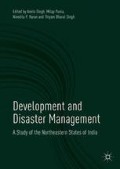Abstract
The people of Manipur have undergone the affliction of natural disasters in different ways as it is located in one of the most vulnerable and high disaster risk zone. This paper studies how a tribal community namely Paitei tribe in Manipur engaged to tackle natural disasters in their own approach. The Paites (Paites is considered as the plural form of people of the Paite tribe.) living in Manipur have reacted to the recurrent flood and hailstorm that caused damages to lives and property. This paper also highlights the disorganized and ill-approach of the government in reduction of disaster risk and the much needed for social intervention on natural disasters. The local community with its strong bonding on ethnic line is prominent even in disaster relief management. However, the unawareness and unpreparedness of the society as a whole is the challenge that could be immediately addressed to the community in response to events of natural disaster of the study area.
Access this chapter
Tax calculation will be finalised at checkout
Purchases are for personal use only
Notes
- 1.
UNISDR. (2015). Sendai Framework for Disaster Risk Reduction 2015–2030. UNISDR, United Nation, p. 23.
- 2.
Ibid., p. 23.
- 3.
Survey of India, GOI; Seismic Zones of India Map IS: 1893–2002. Retrieved from http://www.hpsdma.nic.in%2FResourceList%2FMaps%2FEqIndia.pdf.
- 4.
Weiner, J. M., and Jr. J. J. Walsh. (2015). Community Resilience Assessment and Literature Analysis. Journal of Business Continuity & Emergency Planning, 9(1), p. 86.
- 5.
Literally, Lamka derives from the Paitei tribe word where ‘lam’ means ‘road’ and ‘ka’ means ‘divergence’ as the main road from Imphal capital diverge into two road at Lamka town, where one road, i.e. Tedim Road leads to Myanmar and another one ‘Tipaimukh Road’ leads to Mizoram State.
- 6.
Census of India. (2011). District Census Handbook Churachandpur, Village and Town Wise, Primary Census Abstract (PCA), Directorate of Census Operations, Manipur.
- 7.
Census of India, 2011.
- 8.
Siamkhum, Th. (2013). The Paiteis: A Study of the Changing Faces of the Community. Chennai: Notion Press, p. 7.
- 9.
Ibid., p. 195.
- 10.
Ibid., p. 204.
- 11.
Paitei Tribe Council. (2013). Paitei Customary Law & Practices, 2nd Amendment, 2013. Lamka, Manipur: Lamka Super Printer.
- 12.
Retrieved from http://ebc-india.org/about/history.html.
- 13.
Ibid., p. 93.
- 14.
Pargament, I. K., and J. Cummings. (2010). Anchored by Faith: Religion as a Resilience Factor. In J. W. Reich, A. Zautra, and J. S. Hall (eds.), Handbook of Adult Resilience. New York, NY: Guilford Press, p. 207.
- 15.
Census of India, 2011.
- 16.
Misanya, D., and A. O. Oyhus. (2014). How Communities’ Perceptions of Disasters Influence Disaster Response: Managing Landslides on Mount Elgon, Uganda. Disasters, 39(2), p. 403.
- 17.
- 18.
- 19.
- 20.
Retrieved from http://earthquaketrack.com/p/india/manipur/recent.
- 21.
- 22.
Cutter, S. L., et al. (2008). A Place-Based Model for Understanding Community Resilience to Natural Disaster. Global Environmental Change, 18(4), p. 601.
- 23.
- 24.
Das, O. K. (2009). Baseline Survey of Minority Concentrated Districts District Report CHURACHANDPUR, Institute of Social Change and Development, Study Commissioned by Ministry of Minority Affairs, Government of India, p. 33.
- 25.
- 26.
- 27.
Serna, L. (1983). Disasters and Development: Same Mistakes All Over Again? [Review of the book Disasters and Development by Cuny, Frederick C.]. New York: Oxford University Press, p. 154.
- 28.
- 29.
Ibid., p. 154.
- 30.
Ibid., p. 154.
- 31.
Ibid., p. 207.
- 32.
Ibid., p. 390.
Bibliography
Census of India. (2011). District Census Handbook Churachandpur, Village and Town Wise, Primary Census Abstract (PCA), Directorate of Census Operations, Manipur.
Cutter, S. L., et al. (2008). “A Place-Based Model for Understanding Community Resilience to Natural Disasters”. Global Environmental Change, 18(4), pp. 598–606. https://doi.org/10.1016/j.gloenvcha.2008.07.013.
Das, O. K. (2009). Baseline Survey of Minority Concentrated Districts District Report CHURACHANDPUR, Institute of Social Change and Development, Study Commissioned by Ministry of Minority Affairs, Government of India.
Misanya, D., and A. O. Oyhus. (2014). “How Communities’ Perceptions of Disasters Influence Disaster Response: Managing Landslides on Mount Elgon, Uganda”. Disasters, 39(2), pp. 389–405. https://doi.org/10.1111/disa.12099.
Paite Tribe Council. (2013). Paite Customary Law & Practices, 2nd Amendment, 2013. Lamka, Manipur: Lamka Super Printer.
Pargament, I. K., and J. Cummings. (2010). “Anchored by Faith: Religion as a Resilience Factor”. In J. W. Reich, A. Zautra, and J. S. Hall (eds.), Handbook of Adult Resilience. New York, NY: Guilford Press, pp. 193–211.
Serna, L. (1983). Disasters and Development: Same Mistakes All Over Again? [Review of the Book Disasters and Development by Cuny, Frederick C.]. New York: Oxford University Press, pp. 153–156.
Siamkhum, Th. (2013). The Paites: A Study of the Changing Faces of the Community. Chennai: Notion Press.
UNISDR. (2015). Sendai Framework for Disaster Risk Reduction 2015–2030. UNISDR, United Nation.
Weiner, J. M., and Jr. J. J. Walsh. (2015). “Community Resilience Assessment and Literature Analysis”. Journal of Business Continuity & Emergency Planning, 9(1), pp. 84–93.
Author information
Authors and Affiliations
Editor information
Editors and Affiliations
Rights and permissions
Copyright information
© 2018 The Author(s)
About this chapter
Cite this chapter
Guite, M.P., Vualzong, L. (2018). Community Resilience Building and the Role of Paitei Tribe of Churachandpur in Manipur. In: Singh, A., Punia, M., Haran, N., Singh, T. (eds) Development and Disaster Management. Palgrave Macmillan, Singapore. https://doi.org/10.1007/978-981-10-8485-0_22
Download citation
DOI: https://doi.org/10.1007/978-981-10-8485-0_22
Published:
Publisher Name: Palgrave Macmillan, Singapore
Print ISBN: 978-981-10-8484-3
Online ISBN: 978-981-10-8485-0
eBook Packages: Political Science and International StudiesPolitical Science and International Studies (R0)

